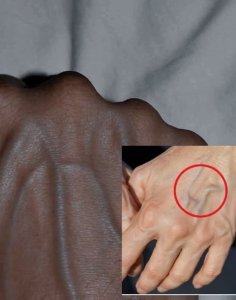Visible Hand Veins: What They Really Mean About Your Health
You may have looked down at your hands and noticed something striking — blue, bulging veins crisscrossing your skin. For some, they’re a badge of hard work; for others, a sign of aging. But viral posts claim: “If you have these visible veins in your hand, it’s a sign of cancer!”
But is there any truth to this? Let’s break it down.
What Causes Veins to Become More Visible?
First, let’s understand the science.
Veins are the blood vessels that return deoxygenated blood from your body back to your heart. Unlike arteries, which are buried deeper, veins often lie closer to the skin — especially in the hands, arms, and feet. Their visibility is influenced by several factors:
1. Low Body Fat
Fat acts as insulation and padding beneath the skin. When someone has low body fat, especially athletes or very lean individuals, their veins become more pronounced. This is a normal, harmless condition.
2. Age
As we age, the skin loses collagen and becomes thinner. This causes veins to appear more prominent, even if your weight remains the same.
3. Genetics
Some people are just genetically predisposed to more prominent veins. If your parents had them, you likely will too — regardless of health status.
4. Heat and Exercise
During a workout or when it’s hot, blood flow increases, and your veins dilate (expand) to help regulate body temperature. The result? Veins that look bigger and more visible.
5. Hormones
Fluctuations, particularly in women due to pregnancy or hormonal changes, can cause veins to become more prominent temporarily.
The Viral Claim: A Sign of Cancer?
Several clickbait-style posts have circulated on social media suggesting that visible hand veins might indicate underlying cancer — particularly blood cancers like leukemia or conditions like deep vein thrombosis (DVT).
Let’s be clear: most visible veins are NOT a sign of cancer. However, there are some rare situations where changes in veins can be a symptom of something more serious — though not isolated to your hands.
When Should You Be Concerned?
Doctors emphasize that context is key. Visible veins alone are not dangerous, but if they are accompanied by the following symptoms, you should consult a healthcare provider:
-
Sudden swelling in the hands or arms
-
Pain or tenderness around the veins
-
Discoloration (red, purple, dark blue)
-
A firm or rope-like vein that feels tender to the touch
-
Unexplained weight loss or fatigue
-
Shortness of breath (if veins in chest or neck are bulging too)
These signs might point to conditions like:
-
Thrombophlebitis: Inflammation and clotting in a vein
-
Vascular tumors (rare)
-
Superior vena cava syndrome: A blockage in the vein that carries blood from the upper body to the heart
-
Certain types of cancer, such as lymphoma or metastatic tumors pressing on veins internally
However, these conditions don’t manifest just as “visible hand veins.” They usually come with systemic signs or more localized pain, swelling, or changes in function.
The Rise of Vein Awareness on Social Media
So why is everyone suddenly worried about hand veins?
Thanks to TikTok, Instagram reels, and health influencers, there’s been a rise in “hyper-health awareness” — sometimes for better, often for worse. One viral video showed a close-up of a woman’s hand veins, warning “Don’t ignore this sign!” It racked up millions of views, stoking panic in people who never before noticed their own veins.
Doctors warn against self-diagnosing based on social media. Dr. Elaine Matthews, a vascular surgeon from Cleveland Clinic, explains:
“I’ve had patients come in terrified because they saw something on the internet. Most of the time, they’re completely healthy. Veins are like fingerprints — we all have different ones, and they change over time.”
Cultural Shifts: From Insecurity to Aesthetic Trend
Interestingly, what used to be seen as a flaw is now sometimes seen as attractive.
Visible hand or arm veins have become an unexpected beauty trend. Fitness influencers, especially male bodybuilders, strive for “vascularity” — the visible roadmap of veins across muscle — as a sign of strength and peak conditioning.
Even among women, “veiny hands” are getting attention. In some circles, it’s considered a marker of dedication to fitness and clean eating. High-fashion models often showcase long, lean arms where veins naturally show.
So while some fear it, others flaunt it.
Can You Get Rid of Hand Veins?
If your veins bother you aesthetically, treatments are available — though they’re usually cosmetic, not medical:
-
Sclerotherapy: A chemical is injected into the vein, collapsing it.
-
Laser therapy: Used for spider veins and smaller visible vessels.
-
Vein stripping or microphlebectomy: Surgical options in extreme cases.
However, doctors caution against removing healthy veins unnecessarily, especially in the hands where veins can serve as important access points for IVs or blood draws in the future.
What You Can Do: Healthier Circulation Tips
Even though visible veins are often normal, it’s smart to support your vascular health:
✅ Stay hydrated — dehydration makes veins less elastic
✅ Exercise regularly — movement keeps blood flowing
✅ Don’t sit or stand for too long — circulation stagnates
✅ Elevate your hands or arms occasionally if they feel heavy
✅ Wear compression gloves/sleeves if prone to swelling
Final Verdict: What Do Hand Veins Really Say About You?
In most cases, visible veins in your hands are just a normal part of aging, genetics, or fitness. They don’t mean you’re sick, and they certainly aren’t a sign of cancer by themselves.
Still, being tuned into your body is a good thing. If the appearance of your veins suddenly changes — or you have accompanying symptoms — it’s always worth speaking to a medical professional.
But if you’re simply noticing the blue highways across your hands in brighter light or after a long run — congratulations. Your body is doing exactly what it’s supposed to.


